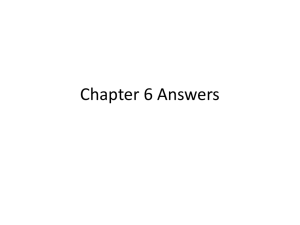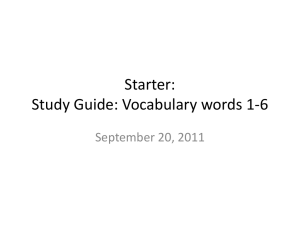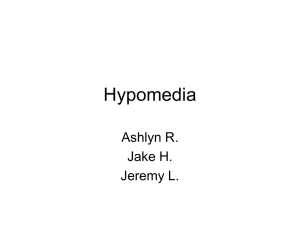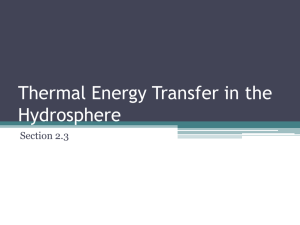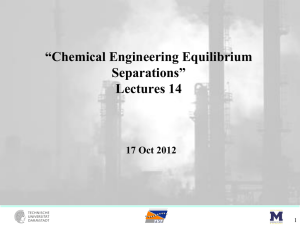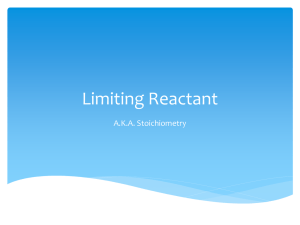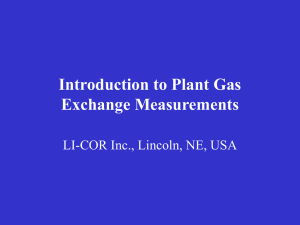ppt unit 4 stoichiometry
advertisement
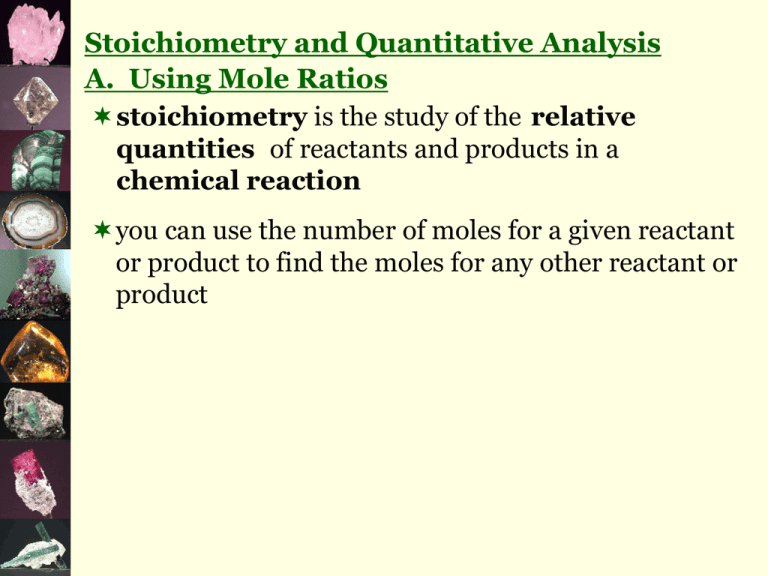
Stoichiometry and Quantitative Analysis A. Using Mole Ratios stoichiometry is the study of the relative quantities of reactants and products in a chemical reaction you can use the number of moles for a given reactant or product to find the moles for any other reactant or product Example Consider the following chemical reaction: 2 C2H6(g) + 7 O2(g) 4 CO2(g) + 6 H2O(g) a) Write the ratio for all components of the reaction. 2:7:4:6 b) What amount, in moles, of CO2(g) is formed if 2.50 mol of C2H6(g) reacts? 2 C2H6(g) n = 2.50 mol + 7 O2(g) 4 CO2(g) + 6 H2O(g) n = 2.50 mol 4 2 = 5.00 mol c) What amount, in moles, of O2(g) is required to react with 10.2 mol of C2H6(g)? 2 C2H6(g) n = 10.2 mol + 7 O2(g) 4 CO2(g) + 6 H2O(g) n = 10.2 mol 7 2 = 35.7 mol d) What amount, in moles, of H2O(g) is formed when 100 mmol of CO2(g) is formed? 2 C2H6(g) + 7 O2(g) 4 CO2(g) + 6 H2O(g) n = 100 mmol n = 100 mmol 6 4 = 150 mmol = 0.150 mol B. Gravimetric Stoichiometry gravimetric = mass measurements Steps 1. Write a balanced equation including the states. Write the information given. 2. Find the moles of the given species using n=m M 3. Find the moles of the wanted mole ratio wanted given species using 4. Calculate mass of the wanted species using m=nM Example 1 Iron is produced by the reaction of iron(III) oxide with carbon monoxide to produce iron and carbon dioxide. What mass of iron(III) oxide is required to produce 1000 g of iron? g w 2 Fe(s) 1 Fe2O3(s) + 3 CO(g) + 3 CO2(g) m = 1000 g m=? M = 55.85 g/mol M = 159.70 g/mol n = 17.90… x 1 n=m 2 M = 8.95… mol = 1000 g 55.85g/mol m = nM = 17.90… mol = (8.95… mol)(159.70 g/mol) = 1429.7225 g = 1430 g Example 2 The decomposition of the mineral malachite, Cu2(CO3)(OH)2(s), yields copper(II) oxide, carbon dioxide and water vapour. What mass of copper(II) oxide is produced from 1.00 g of malachite? g w 2 CuO(s) + 1 CO2(g) + 1 H2O(g) 1 Cu2(CO3)(OH)2(s) m=? m = 1.00 g M = 79.55 g/mol M = 221.13 g/mol n = 0.00452… x 2 n= m 1 M = 0.00904… mol = 1.00 g 221.13 g/mol m = nM = 0.00452… mol = (0.00904… mol)(79.55 g/mol) = 0.7194862 g = 0.719 g C. Solution Stoichiometry use concentration to perform calculations c=n v Example 1 What volume of 14.8 mol/L KOH is needed to react completely with 1.50 L of 12.9 mol/L sulphuric acid? w g 2 KOH(aq) + 1 H2SO4(aq) 1 K2SO4(aq) + 2 H2O(l) v=? v = 1.50 L c= 14.8 mol/L c = 12.9 mol/L n = 19.35 x 2 1 = 38.70 mol v=n c = 38.70 mol 14.8 mol/L = 2.6148649 L = 2.61 L n = cv = 12.9 mol/L x 1.50 L = 19.35 mol D. Law of Combining Volumes you can use the Law of Combining Volumes when the pressure and temperature conditions are constant for both the reactants and the products Example Consider the following reaction: N2(g) + 2 O2(g) N2O4(g) a) What is the mole ratio for O2(g) and N2O4(g)? 2:1 b) What is the volume ratio for O2(g) and N2O4(g)? 2:1 c) If 1 mol of N2O4(g) is produced, how many moles of O2(g) must be consumed? 1 mol of N2O4(g) 2 1 = 2 mol of O2(g) d) If 1 L of N2O4(g) is produced, what volume of O2(g) must be consumed? 1 L of N2O4(g) 2 1 = 2 L of O2(g) e) If 2.5 L of N2(g) is consumed, what volume of O2(g) must be consumed? 2.5 L of N2(g) 2 1 = 5.0 L of O2(g) E. Gas Stoichiometry if the other information is given for the chemicals in the reaction (eg. mass), use ideal gas law to perform calculations PV = nRT Example 1 If 300 g of propane burns in a gas barbeque, what volume of oxygen at SATP is required for the reaction? w g 3 CO2(g) + 4 H2O(g) 1 C3H8(g) + 5 O2(g) m = 300 g M = 44.11 g/mol n=m M = 300 g 44.11 g/mol = 6.80… mol v=? P = 100.000 kPa T = 298.15 K R = 8.314 kPaL/molK n = 6.80… mol x 5 1 = 34.0… mol PV = nRT (100.000kPa)V = (34.0… mol)(8.314)(298.15K) V = 842.94…L = 843 L Chapter 8: Applications of Stoichiometry 8.1 Limiting and Excess Reagents let’s make double burgers… 1 bun + 2 meat patties 1 double burger 2 buns + 4 meat patties 2 double burgers 2 buns + 2 meat patties 1 double burger excess limiting 2 buns + one million meat patties 2 double burgers limiting excess limiting reagent = the reactant that determines how much product can be formed in a reaction excess reagent = the reactant that is present in larger quantities than necessary Steps 1. Write the balanced chemical equation, including states. 2. Calculate the number of moles of each reactant using n=m M 3. “Even out ” the number of moles for each reactant by dividing by the coefficient in the balanced equation and compare…the one with the lowest number of moles is the limiting reagent 4. Use limiting reagent moles to calculate the answer. Example 1 When 80.0 g copper and 25.0 g of sulphur react, which reactant is limiting and what is the maximum amount of copper(I) sulphide that can be produced? g 16 Cu(s) + m = 80.0 g M = 63.55 g/mol n = 80.0 g 63.55g/mol = 1.25… mol n/16 = 0.0786…mol \ limiting 1 S8(s) m = 25.0 g M = 256.56 g/mol n = 25.0 g 256.56g/mol = 0.0974… mol w 8Cu2S(s) m=? M = 159.17 g/mol n = 1.25…mol 8/16 = 0.629… mol n/1 = 0.0974… mol \ excess m = (0.629…mol ) (159.17 g/mol) = 100.17… g = 100 g Example 2 You are supplied with 9.00 g of KCl and 6.50 g of AgNO3. What is the mass of the precipitate formed when these two chemicals react? 1 KCl(aq) + m = 9.00 g M = 74.55 g/mol n = 9.00 g 74.55g/mol =0.120… mol n/1 = 0.120…mol \ excess 1 AgNO3(aq) 1 KNO3(aq) + 1 AgCl(s) m = 6.50 g M = 169.88 g/mol n = 6.50 g 169.88g/mol = 0.0382… mol m=? M = 143.32 g/mol n =0.0382… mol 1/1 n/1 = 0.0382… mol \ limiting m = (0.0382…mol ) (143.32 g/mol) = 5.48 g Example 3 A 200 mL sample of a 0.221 mol/L mercury (II) chloride solution reacts with 100.0 mL of a 0.500 mol/L solution of sodium sulphide. What is the mass of the precipitate formed? 1 HgCl2(aq) + 1 Na2S(aq) 2 NaCl(aq) + 1 HgS(s) C = 0.221 mol/L V = 0.200 L n = CV =(0.221 mol/L) (0.200 L) =0.0422… mol n/1 = 0.0422…mol \ limiting C = 0.500 mol/L V = 0.1000 L n = CV =(0.500 mol/L) (0.1000 L) =0.0500… mol m=? M = 232.66 g/mol n =0.0422…mol 1/1 n/1 = 0.0500… mol m = (0.0422…mol ) (232.66 g/mol) =10.3 g 8.2 Predicted and Experimental Yield the expected amount of product is called the predicted or theoretical yield the quantity of the product actually obtained is called the experimental or actual yield it is extremely rare for the predicted and experimental yield to be the same factors affecting the experimental yield include: 1. two chemicals can react to give different products …called competing reactions eg) C(s) and O2(g) can react to form CO2(g) or CO(g) 2. reaction is very slow 3. collection and transfer methods 4. reactant or product purity 5. reaction doesn’t go to completion ideally, percent yield should be as close to 100% as possible percent yield is calculated as follows: % yield = actual yield 100 predicted yield we can also calculate our % error for the experiment, which tells us how far we are from the theoretical yield the closer to zero the percent error is, the better the experiment % error = actual yield – predicted yield predicted yield 100 Example 1 Calculate the % error and % yield for the following: predicted mass of ppt = 6.20 g actual mass of ppt = 7.12 g % error = 7.12 g - 6.20 g x 100 6.20 g = 14.8 % % yield = 7.12 g x 100 6.20 g = 115 % Example 2 Calculate the % error and % yield for the following: predicted mass of ppt = 100 g actual mass of ppt = 93.5 g % error = 93.5 g - 100 g x 100 100 g = -6.50 % % yield = 93.5 g x 100 100 g = 93.5 % 8.3 Acid-Base Titration A. Titrations in solution stoichiometry, sometimes you don’t have enough information to solve the problem on paper eg) 10 mL of acetic acid reacts with a 0.202 mol/L NaOH solution. What is the concentration of the acetic acid? CH3COOH(aq) + NaOH(aq) H2O(l) + NaCH3COO(aq) c = 0.202 mol/L x mol/L v = 0.0100 L v = ??? ***** **** you need this volume in order to solve the problem a titration is a procedure used to find the volume of substances so you can calculate concentration standardization is when a solution of known concentration, a standard solution , is reacted with a solution of unknown concentration both strong acids and strong bases need to be standardized since their concentrations will change over time a solution called the titrant is transferred from a precisely marked tube called a burette to a flask containing the sample and an indicator an indicator (eg. methyl orange, bromothymol blue) is used because a sudden change in colour indicates the completion of the reaction the endpoint is the point where the titrant reacts completely with the sample equivalence point is the volume needed to reach the endpoint you need a minimum of 3 trials within 0.20 mL of each other to ensure results are accurate Here is a website to view a virtual titration: Virtual Titration (Click on the “View Tutorial” beside Section 16.716.8 Strong Acid and Strong Base Titration) Example A 10.00 ml sample of HCl(aq) was titrated with a standardized solution of 0.685 mol/L NaOH(aq). Bromothymol blue indicator was used and it changes from yellow to blue at the endpoint. What is the concentration of the HCl(aq)? Note: HCl(aq) “is titrated with” NaOH(aq) sample in flask titrant in burette Data Table Trial 1 overshoot Final Volume (mL) Initial Volume (mL) Volume NaOH (mL) Endpoint Colour 2 3 4 average volume = ( + + ) 3 = mL 1 HCl(aq) + 1 NaOH(aq)→ 1 H2O(l) + 1 NaCl(aq) x mol/L C = 0.685 mol/L V = 10.00 mL V= mL = 0.01000 L = L n= n= = mol C=n V = = B. Titration Curves a plot of the pH vs. the volume of titrant added is called a pH titration curve titration curves are S-shaped when a strong monoprotic acid is titrated with a strong monoprotic base, the equivalence point will always have a pH of 7 (at 25C) the first point on the curve is always the pH of the sample the pH changes very gradually at first…this is called the buffer region as the endpoint is approached, the pH changes very rapidly the overtitration is asymptotic to the pH of the titrant Strong Acid Titrated with Strong Base 14 pH 7 0 volume of titrant added (mL) Strong Base Titrated with Strong Acid 14 pH 7 0 volume of titrant added (mL) C. Indicators for Titrations pH meters can be used to carry out a titration but it is much more convenient to use an indicator the indicator should change colour immediately after the endpoint is reached the pH of the endpoint should fall within the pH range of the indicator Review assignment: p. 328 #1-33 (omit 22)


